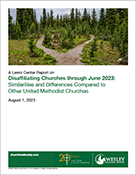The Lewis Center has issued an updated report on the characteristics of churches disaffiliating from the United Methodist Church that covers more than 6,100 churches approved for disaffiliation through June 2023. There continue to be more similarities than differences between the cohort of disaffiliating churches and the total pool of United Methodist churches. But disaffiliating churches are disproportionately in the Southeastern and South Central Jurisdictions, they are less likely to be served by an active elder, they are disproportionately white, and they are more likely to have a male lead pastor.
Read and download the full Disaffiliating Churches through June 2023 report.
The Lewis Center for Church Leadership has released an updated report examining the ways in which congregations leaving the United Methodist Church are similar to or different from the profile of United Methodist Churches as a whole. This new report, Disaffiliating Churches through June 2023: Similarities and Differences Compared to Other United Methodist Churches, includes more than 6,100 churches approved for disaffiliation between 2019 and June 2023. It updates a preliminary report issued in March that examined the approximately 2,000 churches that had disaffiliated through the end of 2022. (See Disaffiliating Churches through 2022: Similarities and Differences Compared to Other United Methodist Churches) With the addition of 4,000 churches since the earlier report, the patterns seen in the first group of disaffiliating churches tend to continue as more churches join their ranks.
There continue to be more similarities than differences in comparing the cohort of disaffiliating churches with the total pool of all United Methodist churches.
- The median worship attendance of disaffiliating churches and those remaining is identical.
- The percentages of churches showing an increase in attendance are similar in the two groups with disaffiliating churches growing slightly more.
- The age of membership estimated on the basis of death rates is the same.
- The age distribution of the pastors serving disaffiliating churches and all United Methodist churches tends to be the same.
- Professions of faith are reported at about the same rates among both groups.
- Apportionments are paid at about the same rates.
- Both groups of churches receive equitable compensation and other conference or district support at about the same rate.
However, there continue to be key differences as well. Disaffiliating churches are disproportionately in the Southeastern and South Central Jurisdictions. And compared to all United Methodist Churches, disaffiliating churches are less likely to be served by an active elder, they are disproportionately white, and they are more likely to have a male lead pastor.
Some of the most noteworthy findings in the Lewis Center’s report are as follows.
Disaffiliating churches are the same size as all United Methodist churches.
From the beginning of the disaffiliation process, the sizes of churches disaffiliating and those remaining have been nearly the same. The median worship attendance (half larger, half smaller) for disaffiliating churches through June 2023 is 38, which is exactly the same as the median worship attendance for all United Methodist Churches. Looking across different size groupings, disaffiliating churches and all United Methodist churches tend to match in the sizes of congregations based on worship attendance cohorts. The percentages are not exactly the same in every size group but always very close to each other.
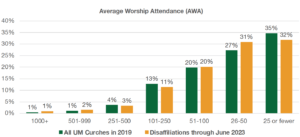
Disaffiliating churches and members are disproportionately Southern.
The two Southern jurisdictions (South Central and Southeastern) at the beginning of the disaffiliation process had 9 percent more churches than the other three jurisdictions (North Central, Northeastern, and Western). However, there are 56 percent more disaffiliating churches from the SCJ and SEJ than from the other three jurisdictions combined. In terms of membership, at the beginning of the disaffiliation process, the SCJ and SEJ had 42 percent more members than the NCJ, NEJ, and WJ. There are 70 percent more members among disaffiliating churches from the SCJ and SEJ than from the other three jurisdictions combined. The makeup of disaffiliating churches is less Southern after the additional 4,000 disaffiliations approved between January and June 2023 as the range of conferences approving disaffiliations expanded.
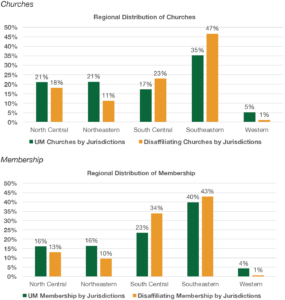
Disaffiliating churches are less likely to have an elder as pastor.
Compared to all United Methodist churches, disaffiliating churches have pastors who are less likely to be an active elder. Only 37 percent of disaffiliating churches were served by an active elder compared to 43 percent for all United Methodist churches. The difference for disaffiliating churches is made up by local pastors and lay supply pastors.
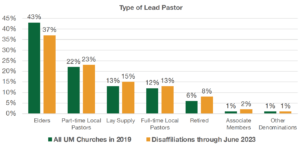
Disaffiliating churches disproportionately have white membership.
Among disaffiliating churches, 97.8 percent report majority-white membership compared to 89.6 percent of United Methodist churches as a whole that have majority-white membership.
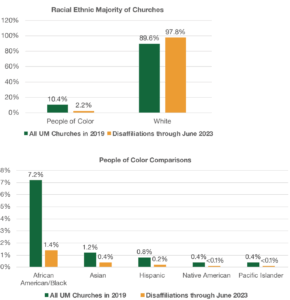
New online program from Wesley Pathways for Ministry
Take Your Ministry to the Next Level with the Lewis Center Church Leadership Certificate Program
Designed as an equivalent to an executive leadership program, the Lewis Center Church Leadership Certificate Program delivers an online, cohort-based learning experience for pastors combining self-study and interactive peer learning. Participants will learn strategic actionable insights that enhance their ability to be effective in their ministry settings. The program includes five courses over the course of a year that help pastors explore visioning, administration, stewardship, innovation, and building key partnerships. Space is limited. Learn more and register now.
Disaffiliating churches are more likely to have a male pastor.
Only 16 percent of disaffiliating churches have a woman as lead pastor at the time of disaffiliation compared to 29 percent of United Methodist congregations as a whole who have a clergywoman as lead pastor. This does not represent the proportion of pastors who are disaffiliating or remaining United Methodist themselves. The pastor’s decision to remain a United Methodist pastor or to disaffiliate is a separate decision made by the pastors.
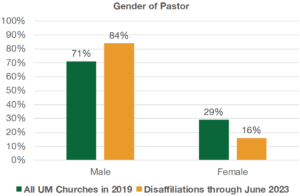
Methodology
This report used 2019 as the comparison year since disaffiliations occurred primarily after 2019. It compares the characteristics that disaffiliating and non-disaffiliating churches had in 2019, before the disaffiliations occurred. For the updated report, the Lewis Center was able to identify the names for 6,155 of the disaffiliating churches. In 2019, there were 30,541 total United Methodist churches in the United States. There are limitations to this approach, but we believe it serves to compare the two sets of churches at a time when we have sufficient data for almost all the churches (the total and those disaffiliating) and before the skewing of statistics that may have occurred during the heart of the pandemic.
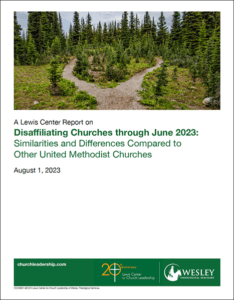 Related Resources
Related Resources
- Disaffiliating Churches through June 2023 by Lovett H. Weems Jr.
- Disaffiliating Churches through 2022 by Lovett H. Weems Jr.
If you would like to share this article in your newsletter or other publication, please review our reprint guidelines.
Cover image by souvenirpixels at freepik



